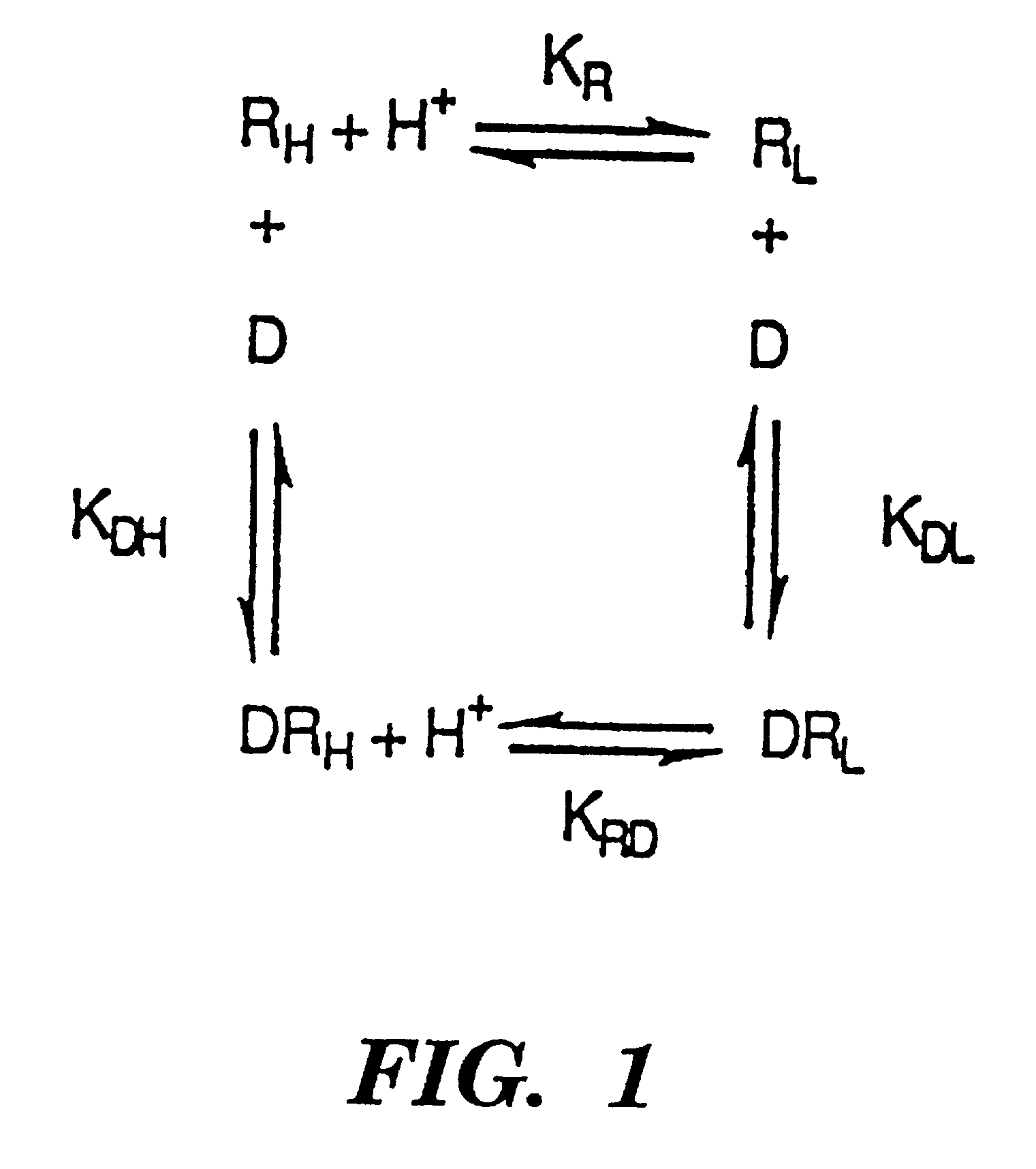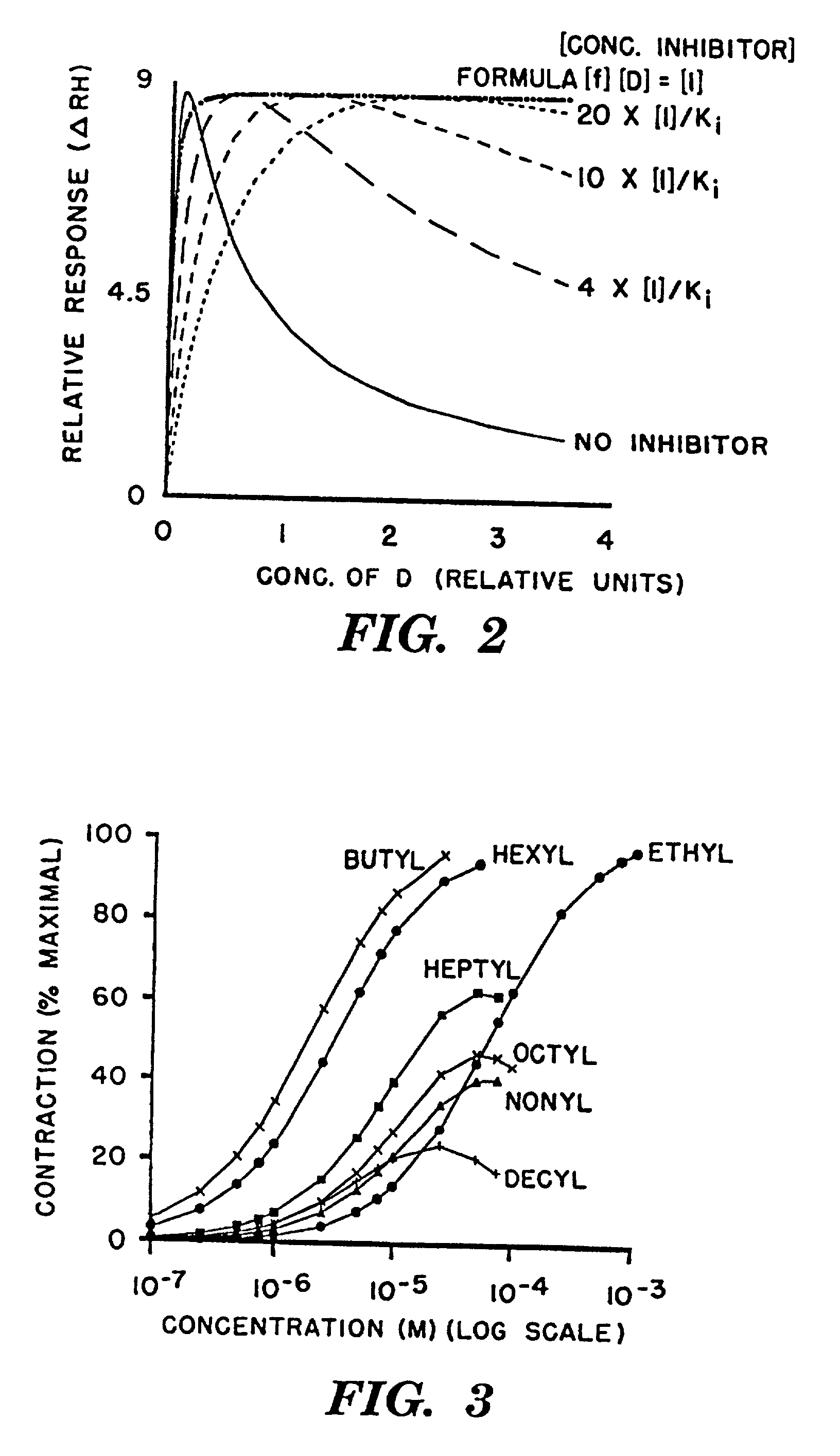Compositions to enhance the efficacy and safety of bio-pharmaceutical drugs
a biopharmaceutical and composition technology, applied in the direction of biocide, instruments, animal husbandry, etc., can solve the problems of difficult model of rapid desensitization the receptor theory fails to describe the observed responses, and the desensitization phenomenon is difficult to model by modem receptor theories, so as to prevent desensitization of cellular receptors, reduce the and reduce the effect of desensitization of the receptor
- Summary
- Abstract
- Description
- Claims
- Application Information
AI Technical Summary
Benefits of technology
Problems solved by technology
Method used
Image
Examples
example 2
[0058] Referring once again to FIG. 4, the plots of .DELTA.R.sub.H (equation [6]-solid lines) for the data of Keen (Keen, 1991) are presented for arecoline, pilocarpine and carbachol as well as the plots of the operational model (broken lines). .DELTA.R.sub.H was calculated with 300 as the value for the R.sub.H and R.sub.L terms to scale the curves appropriately. The K.sub.DH and K.sub.DL terms were varied in order to model the experimental curves. The K.sub.DH and K.sub.DL values for arecoline were 2 and 2000 respectively; similarly, the values for pilocarpine were 4 and 220; and the values for carbachol were 0.02 and 1000.
[0059] The equation to calculate the curves for the operational model: 2 % response = ( [ R O ] / K AR ) ( D / K A )1 + ( 1 + ( [ R O ] / K AR ) ) ( D / K A )
[0060] where ([R.sub.O] / K.sub.AR)=16, 7.3, 3.5, 1.3 and 0.116 with .alpha.=100% (plotted as the broken lines in the graph). KA is the overall dissociation constant for the binding of the agonist to the recep...
example 3
[0067] As depicted in FIG. 5, the response curves of Dilger and Brett are modeled by .DELTA.RH with a diffusion equation, [D]t, to represent the change in concentration with time and a recruitment function, R.sub.F, to describe the diffusional recruitment of receptors. The diffusion coefficient used for acetylcholine (ACH) is 6.times.10-10 m2s-1, which is a generally accepted value. The values for the R.sub.H and R.sub.L terms are one for this graph. The apparent affinity constant for the diffusional recruitment of receptors, K.sub.F, is 20 .mu.M as determined by the half maximal change in the peak heights of the experimental curves. Where "t" is the time in seconds and "900.times.10-12" is the square of the distance (30.times.10-6 m). The K.sub.DH and K.sub.DL values of acetylcholine are 0.01 and 0.1 respectively.
[0068] The series of equations to calculate .DELTA.RH are: 5 R F = 100 D / ( D + K F ) [ D ]t = ( D ) 10 ( t * 6 .times. 10 / 900 .times. 10 )- ( D ) 10 ( t * 6 .times. 10...
example 4
[0071] FIG. 6 consists in the two plots of .DELTA.RH which model the experimental dose-response curves of del Castillo and Katz. .DELTA.RH is computed by the series of sequential equations shown below. The values for the R.sub.H and R.sub.L terms are 100. The initially applied concentration of acetylcholine (ACH) was 100 .mu.M. The values for the maximum peak response of acetylcholine (100 .mu.M) and half maximal peak response (20 .mu.M) were taken from Dilger and Brett for use in the recruitment function, R.sub.F. The effective diffusion distance in [D]t is 191 .mu.m and "t" is the time in seconds which is converted to milli-seconds for the plot. The inhibitor concentration for decamethonium, expressed as I / K.sub.i is equal to either 0 or 1 ([I]=K.sub.i) for the two plots. The recruitment function, R.sub.F, also includes the effect of the competitive inhibitor. Decamethonium, which was a weak partial agonist in the hands of del Castillo and Katz, is treated as a competitive antagon...
PUM
| Property | Measurement | Unit |
|---|---|---|
| Composition | aaaaa | aaaaa |
| Concentration | aaaaa | aaaaa |
| Ratio | aaaaa | aaaaa |
Abstract
Description
Claims
Application Information
 Login to View More
Login to View More - R&D
- Intellectual Property
- Life Sciences
- Materials
- Tech Scout
- Unparalleled Data Quality
- Higher Quality Content
- 60% Fewer Hallucinations
Browse by: Latest US Patents, China's latest patents, Technical Efficacy Thesaurus, Application Domain, Technology Topic, Popular Technical Reports.
© 2025 PatSnap. All rights reserved.Legal|Privacy policy|Modern Slavery Act Transparency Statement|Sitemap|About US| Contact US: help@patsnap.com



